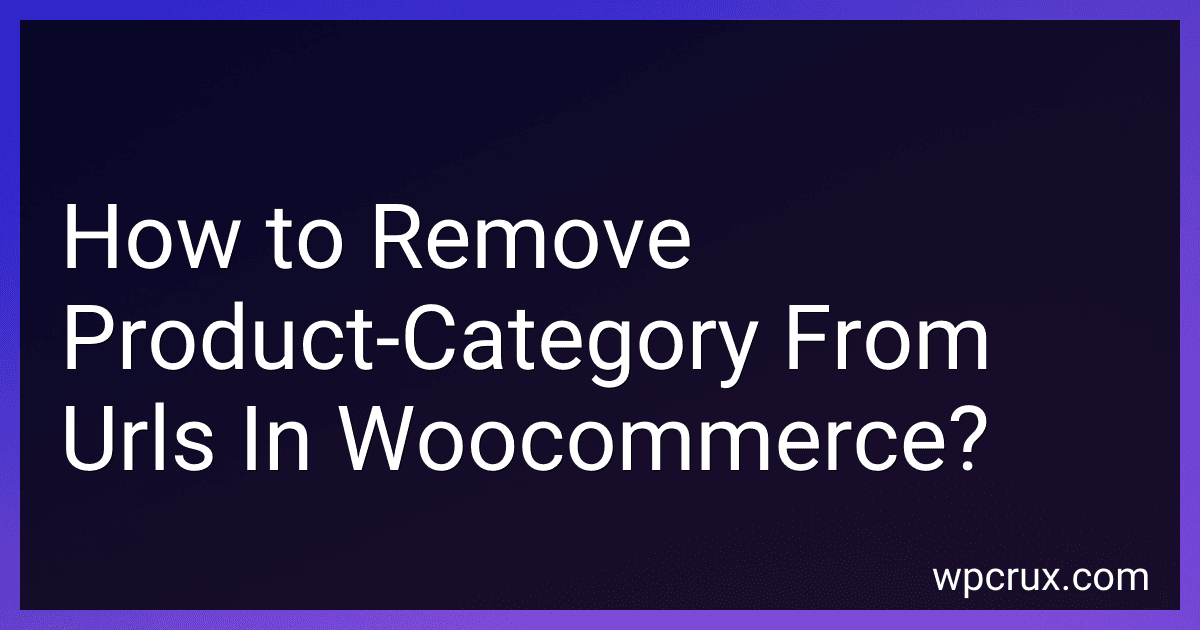Best URL Customization Tools to Buy in October 2025
To remove the product-category from URLs in WooCommerce, you can use a code snippet or a plugin. One way to do this is by adding the following code snippet to your theme's functions.php file:
function custom_rewrite_rules() { add_rewrite_rule('^product-category/(.+?)/?$', 'index.php?product_cat=$matches[1]', 'top'); } add_action('init', 'custom_rewrite_rules');
This code snippet will remove the "product-category" base from your URLs. Another option is to use a plugin like Yoast SEO or Rank Math, which have built-in features to help you customize your permalinks and remove unwanted words from your URLs. Just install and activate the plugin, go to its settings, and find the option to modify the product category URLs. With these methods, you can easily remove product-category from URLs in WooCommerce.
What are the potential drawbacks of removing product-category from URLs in WooCommerce?
- SEO impact: Removing product-category from URLs may have a negative impact on search engine optimization (SEO) as it can reduce the visibility of your products in search engine results. Product-category in URLs help search engines understand the hierarchy and structure of your website, making it easier for them to crawl and index your products.
- User experience: Product-category in URLs can also provide users with information about the category and context of the product they are viewing. Removing this information may confuse users and make it harder for them to navigate your website and find relevant products.
- Broken links and redirection issues: Removing product-category from URLs can create broken links and redirection issues if your website has existing links or internal links that include the product-category. This can negatively impact user experience and lead to a decline in website traffic.
- Difficulty in tracking and analyzing performance: Product-category in URLs can also help track and analyze the performance of your products and categories in terms of traffic, conversions, and other key metrics. Removing this information may make it harder to measure the effectiveness of your marketing campaigns and make data analysis more challenging.
- Impact on marketing strategies: Product-category in URLs can be used as part of your marketing strategies, such as creating targeted campaigns for specific product categories. Removing this information may limit your ability to effectively target and segment your audience based on product categories.
What tools are available to assist with the process of removing product-category from WooCommerce URLs?
- Yoast SEO plugin: This popular plugin allows you to easily customize the structure of your WooCommerce URLs, including removing product-category from the URL structure.
- Permalink Manager plugin: This plugin offers advanced options for managing permalinks, allowing you to easily remove product-category from WooCommerce URLs.
- Coding changes: You can also manually edit the code of your WordPress theme to remove the product-category from the URL structure. This requires some coding knowledge, but can be an effective way to customize the URLs to your liking.
- Redirection plugin: If you have already set up product-category URLs and want to change them, you can use a redirection plugin to create 301 redirects from the old URLs to the new URLs without product-category.
- WordPress Customizer: In some cases, you may be able to customize the URL structure directly within the WordPress Customizer without the need for a separate plugin. This can be a more basic option but can work for simple changes to URL structure.
What role does schema markup play in the optimization of WooCommerce URLs after removing product-category?
Schema markup plays a crucial role in the optimization of WooCommerce URLs after removing product-category as it helps search engines understand the content of your website and display relevant information in search results. By adding schema markup to your product pages, you can provide additional metadata that helps search engines categorize and interpret your content more accurately.
Schema markup can also improve the visibility of your products in search results by providing rich snippets that include information such as prices, ratings, availability, and more. This can increase click-through rates and drive more traffic to your website. Additionally, schema markup can help search engines better understand the structure and hierarchy of your website, making it easier for them to crawl and index your content.
Overall, adding schema markup to your WooCommerce URLs after removing product-category can help improve the visibility and performance of your online store in search engine results pages, ultimately leading to increased traffic and sales.
